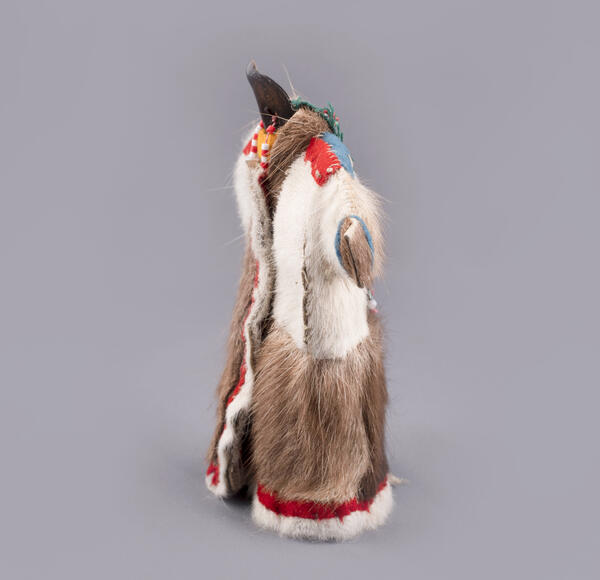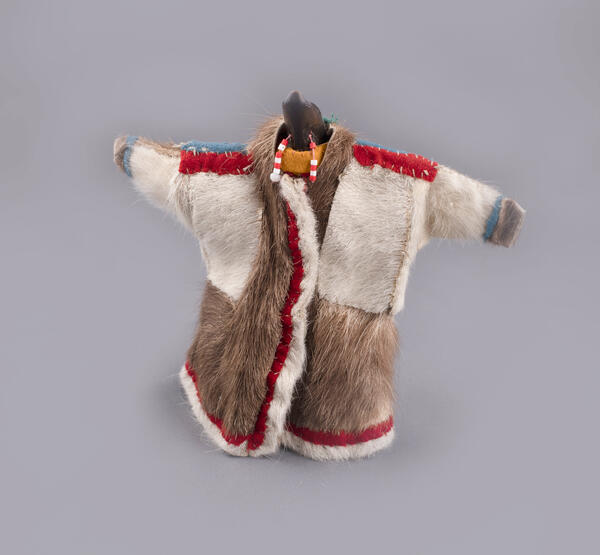From the age of five or six, Nenets girls made their nuhuko dolls on their own or guided by their mother or older sister. These dolls, usually 10–15 cm in height, were conventional figurines of women and men, elders and children. Beaks of different waterfowl could be used to make their heads: goose — for male dolls, duck— for female ones. They had different clothes as well. Each doll’s outfit was a replica of a real Nenets garment.
In this way, the little housewives learned how to choose materials, cut, sew, and decorate clothes — all the jobs they would have to do in the future. There were whole families of dolls, and homes, utensils, and other necessities were made for them. It was customary to carry them along when going on a visit and to prepare gifts on their behalf for the host’s nuhuko.
Female figures were usually not only dressed up but also decorated in some way. They left their faces blank for fear of evil spirits.
The doll’s head is made from the upper bill of a red-breasted goose, and the trapezoidal body is sewn from a piece of cloth. Hair ornaments — strips of green cloth embroidered with beads — are sewn to the beak head; the doll also has earrings — a string with red and white beads, threaded through the nostrils of the beak.
The parka, sewn with cotton threads, is modeled on traditional women’s clothing. A Nenets woman’s wardrobe consists of three kinds of parkas (“pany”): “myakacha pany” for home, “sava pany” for travel, and “mazavy pany” for festivities. Their cut is different from that of men.
Usually, a women’s parka is made of August reindeer skins, which are selected by color and pile length, sometimes over several years. The top part of the parka is sewn from three deer skins, the hem — from a sturdier skin of a young female deer, and the cuffs of the sleeves from the skins of the front part of the deer head.
Mittens made of reindeer leg skin and a white fox collar are sewn directly onto the parka. The lining is made of September deer, fox, or hare skins. The white thin band of deer leg skins on the edge of the sleeves and on the hem is usually trimmed with narrow strips of cloth. The same band is sewn on the shoulder seam. The straight flaps of the parka join together without a wrap and are tied with suede straps.
An indispensable attribute of women’s clothing is a girdle woven from colored yarn, more modest than a man’s. It helps to keep warm for a long time and adds a nice touch to a woman’s look.
In this way, the little housewives learned how to choose materials, cut, sew, and decorate clothes — all the jobs they would have to do in the future. There were whole families of dolls, and homes, utensils, and other necessities were made for them. It was customary to carry them along when going on a visit and to prepare gifts on their behalf for the host’s nuhuko.
Female figures were usually not only dressed up but also decorated in some way. They left their faces blank for fear of evil spirits.
The doll’s head is made from the upper bill of a red-breasted goose, and the trapezoidal body is sewn from a piece of cloth. Hair ornaments — strips of green cloth embroidered with beads — are sewn to the beak head; the doll also has earrings — a string with red and white beads, threaded through the nostrils of the beak.
The parka, sewn with cotton threads, is modeled on traditional women’s clothing. A Nenets woman’s wardrobe consists of three kinds of parkas (“pany”): “myakacha pany” for home, “sava pany” for travel, and “mazavy pany” for festivities. Their cut is different from that of men.
Usually, a women’s parka is made of August reindeer skins, which are selected by color and pile length, sometimes over several years. The top part of the parka is sewn from three deer skins, the hem — from a sturdier skin of a young female deer, and the cuffs of the sleeves from the skins of the front part of the deer head.
Mittens made of reindeer leg skin and a white fox collar are sewn directly onto the parka. The lining is made of September deer, fox, or hare skins. The white thin band of deer leg skins on the edge of the sleeves and on the hem is usually trimmed with narrow strips of cloth. The same band is sewn on the shoulder seam. The straight flaps of the parka join together without a wrap and are tied with suede straps.
An indispensable attribute of women’s clothing is a girdle woven from colored yarn, more modest than a man’s. It helps to keep warm for a long time and adds a nice touch to a woman’s look.






